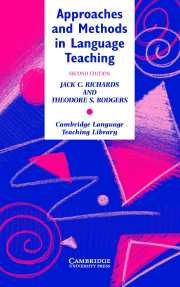Preface
Published online by Cambridge University Press: 06 July 2010
Summary
This is a revised and reorganized version of the first edition, originally published in 1986. More than half of the contents of this new edition has been specially written for this edition. Since the first edition was published, it has become one of the most widely referred to books on teaching methods. Since then, however, a great deal has happened in language teaching. In planning this new edition, we have therefore made a number of substantial changes.
We have divided the book into three main parts:
Part I deals with major trends in twentieth-century language teaching. The chapters in this section are substantially the same as those in the first edition but include an updated list of references.
Part II deals with alternative approaches and methods. This section describes approaches and methods that have attracted support at different times and in different places throughout the last 30 or so years, but have generally not been widely accepted or, in some cases, have not maintained substantial followings. The chapters on Total Physical Response, the Silent Way, Community Language Learning, and Suggestopedia are shorter versions of chapters from the first edition. Additional and more recent references have been added to these chapters. Because these methods are no longer widely used, a shorter treatment seemed appropriate. Readers requiring fuller discussion of these methods should consult the first edition. New chapters on Whole Language, Multiple Intelligences, Neurolinguistic Programming, the lexical approach, and Competency-Based Language Teaching complete Part II. Although these latter approaches share some features with communicative approaches in Part III, we feel that they are sufficiently distinct to be grouped with the other approaches discussed in Part II.
Information
- Type
- Chapter
- Information
- Approaches and Methods in Language Teaching , pp. vii - xPublisher: Cambridge University PressPrint publication year: 2001
